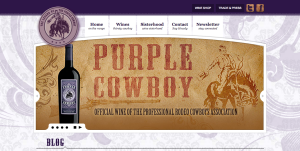What’s Your Marketing Plan for 2013?
Recently, I read a marketing article that said if the fish aren’t biting in your fishing hole, you need to either change your bait, move to a different fishing hole or change your fishing techniques. Look at what you did last year and if you didn’t get the desired results, change the plan.
Start by looking at your marketing plan. Make adjustments to get more visitors in your tasting room, increase sales and reduce stress. If you don’t have a marketing plan yet, here are some simple steps for writing one and getting on the right track for 2013.
1. First, what is your marketing strategy? A marketing strategy outlines what you want to accomplish to meet your business goals. A marketing plan provides details on how to accomplish the marketing strategy. For instance, if a business goal is to add an e-commerce feature on your website to increase sales by 10%, the marketing plan will outline the details of how to accomplish this goal.
2. What is your mission statement? A mission statement describes what you do, how you do it and why you do it. A mission statement is like the north star of your business; guiding your activities and leading the way to achieving goals. Frame your mission statement and hang prominently in the tasting room so all staff and customers can read it. Here’s a great example of a fun, colorful mission statement from Zingerman’s Delicatessen in Ann Arbor Michigan, one of the country’s leading specialty food stores:
3. Who is your target market? What are their wants and needs? You can’t market to everyone, so zero in on those who will buy, and buy a lot. Most businesses have a primary target market that accounts for 30% of sales volume. (Source: Score Blog) Make sure you know who these customers are.
4. Who is your competition? Do a SWAT analysis of your business and assess your competition. A SWAT analysis is a tool to evaluate Strengths, Weaknesses, Opportunities and Threats. By examining what the competition is doing right and what they are doing wrong, maybe you can find a product that they aren’t producing. Could you be the producer for a new niche market product? Think about the potential for adding fruit wines, specialty wines, seasonal wines or charmat products.
5. What is your unique selling proposition? What makes you unique? What sets you apart from the competition? Why should your target market choose your winery or products over the competition? Maybe it’s your great customer service or how your personal passion is expressed at your winery. Here is an example of a unique selling proposition from Purple Cowboy Wine’s website, which is targeting the professional rodeo association. (I am a horse owner so I am their target market.)
6. What is your pricing strategy? How do you decide what to charge for your products and services? This is one of the most difficult aspects of a marketing plan. Some of the factors to consider are: Is your product positioned as a luxury or discount brand? How will price effect demand for your products? What is the cost to produce the product?
7. What is your promotional plan? How will your target market learn about your unique selling proposition? This includes marketing activities such as internet marketing, email marketing, social media, advertising, public relations, direct sales, and promotions.
8. What is the marketing budget? How much money will you spend and on what activities? Break it down into monthly budgets so you can track return on investment. Marketing budget spreadsheets can also be down loaded from Entrepreneur.com or create your own to stay organized.
9. What’s on your action list? Outline exactly what needs to be done and when you need to do it for each of your marketing activities. If implementing an email marketing program is one of your goals, then list all the steps involved including designing, writing, scheduling and frequency. Use a calendar to schedule all your marketing activities to keep on task.
10. Are you tracking results? Track and measure results so you know what’s working and where improvements can be made. For example, online marketing can be tracked with tools like Google Analytics and Facebook Insights. Offline marketing, like print advertising, TV and radio, can be tracked online by using designated domain names with separate landing pages for each domain name. Calls resulting from off line advertising can also be tracked by using multiple phone numbers that correspond with each different ad. The easiest form of call tracking is to ask callers how they heard of your business and document their responses on a phone log.
A marketing plan is an essential part of a successful business. Use these steps to focus on your marketing goals for 2013. For more marketing tips sign-up for my e-newsletter at www.pattyheldconsulting.com.
Book Suggestion:
One of the best books that have changed how I think about planning is “The 12 Week Year” by Brian P. Moran. He says that if we think of a year as 12 weeks, instead of 12 months, we will get more accomplished. Focus on the activities that are most important and maintain a sense of urgency to get those things done. Create a master plan; break that down into 12 week increments, focusing on the most important tasks that will generate positive results.
For more information on creating a marketing plan visit Patty’s website at http://pattyheldconsulting.com/






Great to see you again Patty and REALLY enjoyed your talks at the Illinois Winter Wine Festival
I reviewed our website and found it very user unfriendly. We will be using some of your advise in the near future!!
I would love to hear your imput on wine clubs. I think that is our future.
Thanks Again,
Chris Lawlor
Galena Cellars Vineyard and Winery
Chris,
Thanks! It was a pleasure sharing my ideas with the Illinois wine industry. I was very impressed with the quality of wines in Illinois too!
I would be happy to assist Galena Cellars with their wine club development.
Cheers,
Patty Held